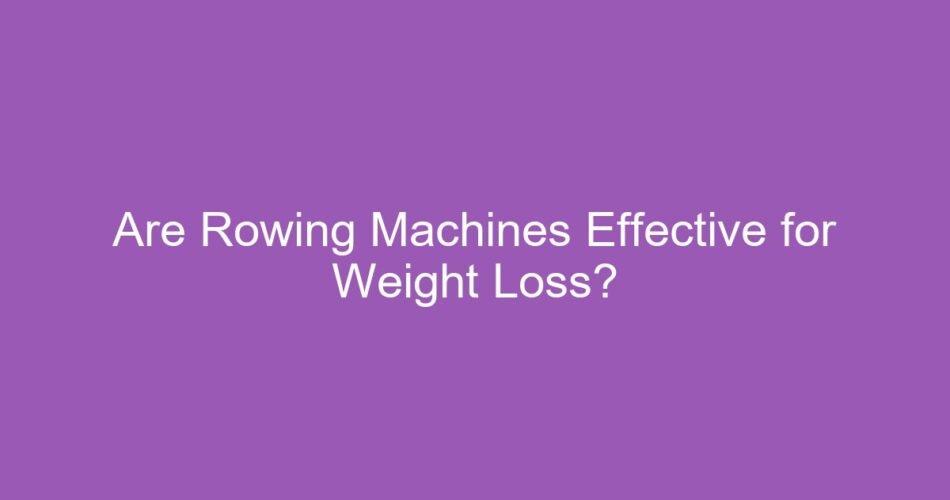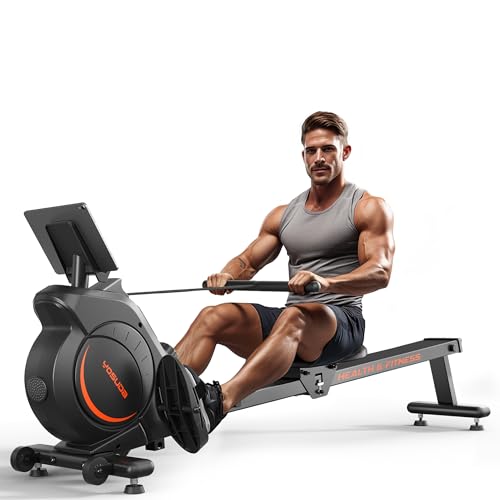Are Rowing Machines Effective for Weight Loss?
Yes, rowing machines are exceptionally effective for weight loss because they offer a total body, high-intensity cardio workout that maximizes calorie burn while simultaneously building metabolism-boosting muscle mass.
Rowing machines are one of the most powerful tools available in home or gym fitness settings for rapidly achieving significant fat loss and weight management goals. When asking are rowing machines effective for weight loss the answer is a resounding yes, primarily because the exercise combines high-output cardiovascular conditioning with resistance training in a single, fluid movement. This compound exercise burns more calories per minute than many comparable forms of low-impact training.
🛒 Recommended Product
The Calorie-Burning Power of Rowing
The ability of the rowing machine, often called an ergometer or “erg,” to drive substantial weight loss is rooted in its incredible efficiency in caloric expenditure. Because rowing requires the coordination and powerful output of the legs, core, and arms, the body must consume a large amount of energy to sustain the movement.
According to data compiled by Harvard Health, a vigorous 30-minute rowing session can burn approximately 377 calories for a 185-pound individual. Over an hour, this translates to roughly 750 calories, positioning rowing at the high end of cardio machines, often surpassing cycling and standard running in terms of total energy consumption.
Key facts regarding caloric efficiency:
- Higher Output: Unlike cycling, which isolates the lower body, rowing requires total muscle recruitment, forcing the heart to work harder to deliver oxygen to numerous muscle groups simultaneously.
- Low Impact: Rowing delivers maximum calorie burn without the joint stress associated with high-impact activities like pavement running, making it sustainable for prolonged weight loss regimes.
- Duration and Consistency: Due to the low-impact nature, users can maintain longer sessions at higher intensities, which is crucial for achieving the consistent caloric deficit necessary for sustainable weight loss.
Why Rowing is a Total Body Exercise
The concept of total body exercise is fundamental to understanding why rowing is so effective for fat loss. When more muscle mass is engaged during an activity, more calories are consumed. Rowing uniquely engages approximately 86% of the body’s skeletal muscles across the four phases of the stroke: the Catch, the Drive, the Finish, and the Recovery.
This recruitment of nearly all major muscle groups provides dual weight loss benefits: immediate calorie burning and long-term metabolism boosting.
Muscle Recruitment Breakdown:
| Body Area | Primary Muscles Engaged | Weight Loss Benefit |
|---|---|---|
| Legs (60%) | Quadriceps, Glutes, Calves | Provides the power phase; largest muscle groups burn the most calories. |
| Core & Back (20%) | Abdominals, Spinal Erectors | Stabilizes the movement; critical for posture and power transfer. |
| Arms & Shoulders (10%) | Biceps, Triceps, Deltoids | Completes the stroke; resistance builds lean muscle mass. |
This compound movement ensures that stored fat is metabolized not just during the exercise, but that the increase in lean muscle tissue (resulting from resistance) enhances the basal metabolic rate (BMR) even when the user is at rest.
🛒 Recommended Product
Maximizing Weight Loss with Intensity Training
For individuals determined to maximize results and understand how to make rowing machines effective for weight loss, the key lies in incorporating intensity. While steady-state cardio burns a consistent amount of calories during the session, high-intensity interval training (HIIT) produces the crucial EPOC (Excess Post-exercise Oxygen Consumption) effect.
The EPOC effect, commonly called the “afterburn,” refers to the elevated oxygen uptake following a strenuous workout. The body consumes extra energy to return to its resting state, meaning you continue to burn calories at an accelerated rate for hours after leaving the machine.
HIIT on the rowing machine involves alternating short bursts of maximal effort (e.g., 30 seconds of all-out rowing) with short recovery periods (e.g., 60 seconds of light rowing). This metabolic shock significantly boosts fat oxidation.
A common HIIT protocol for weight loss might involve:
- Warm-up: 5 minutes of easy rowing.
- Intervals: 15 rounds of 1-minute hard effort followed by 1-minute easy recovery.
- Cool-down: 5 minutes of light rowing and stretching.
This high-intensity approach is highly time-efficient, allowing users to achieve substantial caloric deficits in sessions as short as 20 minutes, which makes the rowing machine a practical tool for busy schedules.
Is Rowing Better Than Other Cardio for Weight Loss?
While all cardio contributes to weight loss, rowing holds several structural advantages over popular alternatives when evaluating total body impact and sustainability.
| Feature | Rowing Machine | Treadmill Running | Stationary Bike |
|---|---|---|---|
| Muscle Groups Engaged | Nearly 90% (Total Body) | Lower body, some core | Lower body, very minimal core/upper |
| Impact on Joints | Extremely low-impact | High-impact (Running) | Low-impact |
| Calorie Burn Potential | Very High (700+ per hour) | High (600+ per hour) | Moderate (450-600 per hour) |
| Lean Muscle Building | Significant (Resistance) | Moderate (primarily legs) | Minimal |
For many fitness experts, the rowing machine provides the perfect synergy: the cardiovascular benefits required for weight loss are combined with the muscle-building stimulus required for long-term metabolic health. This synergy ensures that the weight lost is primarily fat mass, while preserving or building crucial lean muscle.
🛒 Recommended Product
Conclusion
In summary, when analyzing are rowing machines effective for weight loss, the scientific data overwhelmingly supports their use. Rowing’s unique combination of high caloric expenditure, full-body muscle engagement, and capacity for high-intensity interval training makes it an exceptionally powerful and efficient tool for achieving a sustainable caloric deficit and transforming body composition.
Scientific References & Research
The following peer-reviewed research papers provide additional scientific context:
-
A Temraz (2022).
The effectiveness of using a rowing machine for developing aerobic capacity and technical skills in rowing
[External Link] -
H De las Casas et al. (2019).
Eccentric training with a powered rowing machine
[External Link] -
TDT Hetherington (2019).
Effect of Goal-Setting and Visual Feedback on Rower Performance on a Rowing Machine
[External Link]
Note: External research links are provided for educational purposes and do not necessarily represent endorsement.
Frequently Asked Questions About Are Rowing Machines Effective for Weight Loss?
Q. Is rowing machine usage sufficient on its own to achieve notable weight loss, or should it be combined with other strategies?
A. While rowing machines offer an excellent high-calorie-burning workout, achieving sustained weight loss is most effective when combining regular rowing with dietary adjustments. Calorie deficits must primarily be managed through nutrition, and incorporating strength training alongside cardio rowing can help maintain muscle mass while losing fat. Therefore, it should be a component of a holistic strategy including diet and resistance exercise.
Q. What are the advantages of rowing over other popular forms of cardio, such as running or cycling, specifically concerning fat loss?
A. Rowing provides a low-impact exercise option compared to running, minimizing joint stress while still delivering intense cardiovascular benefits suitable for sustained frequent use. Unlike cycling, rowing engages the upper body and core significantly, resulting in higher overall muscle activation and often a greater total calorie expenditure in the same amount of time. This full-body engagement makes it an exceptionally efficient tool for comprehensive fat loss.
Q. How important is workout intensity and duration on the rowing machine for maximizing weight loss results?
A. Both intensity and duration are crucial; moderate-to-high intensity steady-state rowing burns a substantial number of calories over longer periods, while incorporating High-Intensity Interval Training (HIIT) boosts post-exercise oxygen consumption (EPOC). Combining these methods—alternating between long steady-state rows and shorter, high-intensity intervals—optimizes fat oxidation and total energy expenditure, accelerating weight loss progress.
Q. Can muscle building from rowing negatively affect the perceived rate of weight loss, even if fat is being lost?
A. Yes, rowing builds lean muscle mass, especially in the legs, back, and arms, and since muscle is denser than fat, initial weight loss might seem slow or even stall temporarily on the scale. However, this increase in muscle is beneficial as it raises the resting metabolic rate, meaning the body burns more calories throughout the day, which ultimately supports long-term fat loss and a more favorable body composition.
Q. Does consistent rowing lead to an improved resting metabolic rate, further aiding long-term weight management?
A. Absolutely; consistent vigorous exercise, especially full-body workouts like rowing, contributes significantly to building and maintaining lean muscle mass. Muscle tissue requires more energy to sustain than fat tissue, meaning that increasing muscle through rowing naturally elevates the resting metabolic rate (RMR). This higher RMR means the body burns more calories at rest, making it easier to sustain a calorie deficit for long-term weight management.
Q. Are there specific rowing techniques or workout routines, like steady-state versus HIIT, that are better suited for targeting fat loss?
A. Both steady-state and HIIT routines are effective, but they target fat loss differently; steady-state rowing (moderate intensity for 30+ minutes) uses a higher percentage of fat for immediate fuel during the exercise. Conversely, HIIT rowing burns fewer total calories during the workout but maximizes EPOC, leading to significantly higher calorie expenditure post-workout. Optimal fat loss results are typically achieved by regularly incorporating both types of training into a weekly schedule.
Related Articles
What Is the Best Workout Machine for Weight Loss?
Trying to determine what is the best workout machine for weight loss? While several options deliver results, the rowing machine often provides the max…
Do Vibrating Weight Loss Machines Work?
Do vibrating weight loss machines work? The scientific data is clear: while these vibration therapy plates offer proven benefits like muscle stimulati…
Treadmill Workouts for Buttocks: Sculpt and Tone Your Glutes
Getting fit and shaping your buttocks can be challenging. Treadmill workouts might be the solution you need. Treadmill workouts are not just for cardi…
When you purchase a product through Amazon links on EllipticalKing.com, we may earn a small commission at no extra cost to you. This helps support the site and keep our content free.




